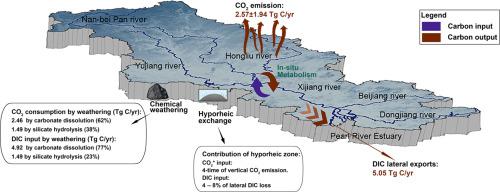当前位置:
X-MOL 学术
›
Water Res.
›
论文详情
Our official English website, www.x-mol.net, welcomes your
feedback! (Note: you will need to create a separate account there.)
Influences of carbonate weathering and hyporheic exchange on carbon fluxes in Pearl River Basin, China
Water Research ( IF 11.4 ) Pub Date : 2024-06-29 , DOI: 10.1016/j.watres.2024.122014 Chao Gu 1 , Yi Liu 2 , Hongkai Qi 3 , Mengqian Lu 4
Water Research ( IF 11.4 ) Pub Date : 2024-06-29 , DOI: 10.1016/j.watres.2024.122014 Chao Gu 1 , Yi Liu 2 , Hongkai Qi 3 , Mengqian Lu 4
Affiliation

|
Deciphering riverine dissolved carbon dynamics is pivotal for a comprehensive picture of the global carbon cycle. Through rigorous in-situ sampling across the Pearl River Basin (PRB), our investigation reveals the Pearl River networks function as a significant carbon source, with the annual carbon dioxide (CO2 ) emission of 2.57 ± 1.94 Tg C, which offsets 10 ± 8 % of the forest carbon sequestration or 65 ± 49 % carbon sink via chemical weathering in the PRB. Based on the mass balance of 222 Rn, we initially reveal that the contributions of water flux from the hyporheic zone increased with the river orders (Hack Order) across both dry and wet seasons. Conversely, the evasion rates of dissolved CO2 (CO2 *) and dissolved inorganic carbon (DIC) from the hyporheic zone into river channels exhibited a decline with the increasing river orders. The hyporheic exchange contributes 4 – 11 % of the lateral and vertical DIC losses, thereby is a key mechanism in the riverine carbon cycle. Furthermore, CO2 * derived from the hyporheic zone was ∼4 times of riverine CO2 emissions and this CO2 * flux from the hyporheic zone was buffered into carbonates/bicarbonates in river channels, due to the high riverine pH resulted from carbonate weathering in the basin. These results not only highlight the substantial role of carbonates and hyporheic processes in modulating riverine carbon fluxes but also signify their broader implications on understanding riverine carbon dynamics at both regional and global scales.
中文翻译:

碳酸盐岩风化和低流交换对珠江流域碳通量的影响
破译河流溶解碳动力学对于全面了解全球碳循环至关重要。通过对珠江流域 (PRB) 进行严格的原位采样,我们的调查揭示了珠江网络是一个重要的碳源,每年的二氧化碳 (CO2) 排放量为 2.57 ± 1.94 Tg C,通过珠江流域的化学风化抵消了 10 ± 8% 的森林碳封存或 65 ± 49% 的碳汇。基于 222Rn 的质量平衡,我们初步揭示了在旱季和湿季,来自低流区的水通量的贡献随着河流目 (Hack Order) 的增加而增加。相反,随着河流订单的增加,溶解 CO2 (CO2*) 和溶解无机碳 (DIC) 从低流区逃逸到河道中的速率呈下降趋势。低流交换贡献了 4 – 11% 的横向和垂直 DIC 损失,因此是河流碳循环中的关键机制。此外,来自低流区的 CO2* 是河流 CO2 排放量的 ∼4 倍,由于流域中碳酸盐风化导致河流的高 pH 值,来自低流区的 CO2* 通量被缓冲到河道中的碳酸盐/碳酸氢盐中。这些结果不仅强调了碳酸盐和低流过程在调节河流碳通量中的重要作用,而且也表明了它们对在区域和全球尺度上理解河流碳动力学的更广泛影响。
更新日期:2024-06-29
中文翻译:

碳酸盐岩风化和低流交换对珠江流域碳通量的影响
破译河流溶解碳动力学对于全面了解全球碳循环至关重要。通过对珠江流域 (PRB) 进行严格的原位采样,我们的调查揭示了珠江网络是一个重要的碳源,每年的二氧化碳 (CO2) 排放量为 2.57 ± 1.94 Tg C,通过珠江流域的化学风化抵消了 10 ± 8% 的森林碳封存或 65 ± 49% 的碳汇。基于 222Rn 的质量平衡,我们初步揭示了在旱季和湿季,来自低流区的水通量的贡献随着河流目 (Hack Order) 的增加而增加。相反,随着河流订单的增加,溶解 CO2 (CO2*) 和溶解无机碳 (DIC) 从低流区逃逸到河道中的速率呈下降趋势。低流交换贡献了 4 – 11% 的横向和垂直 DIC 损失,因此是河流碳循环中的关键机制。此外,来自低流区的 CO2* 是河流 CO2 排放量的 ∼4 倍,由于流域中碳酸盐风化导致河流的高 pH 值,来自低流区的 CO2* 通量被缓冲到河道中的碳酸盐/碳酸氢盐中。这些结果不仅强调了碳酸盐和低流过程在调节河流碳通量中的重要作用,而且也表明了它们对在区域和全球尺度上理解河流碳动力学的更广泛影响。

































 京公网安备 11010802027423号
京公网安备 11010802027423号